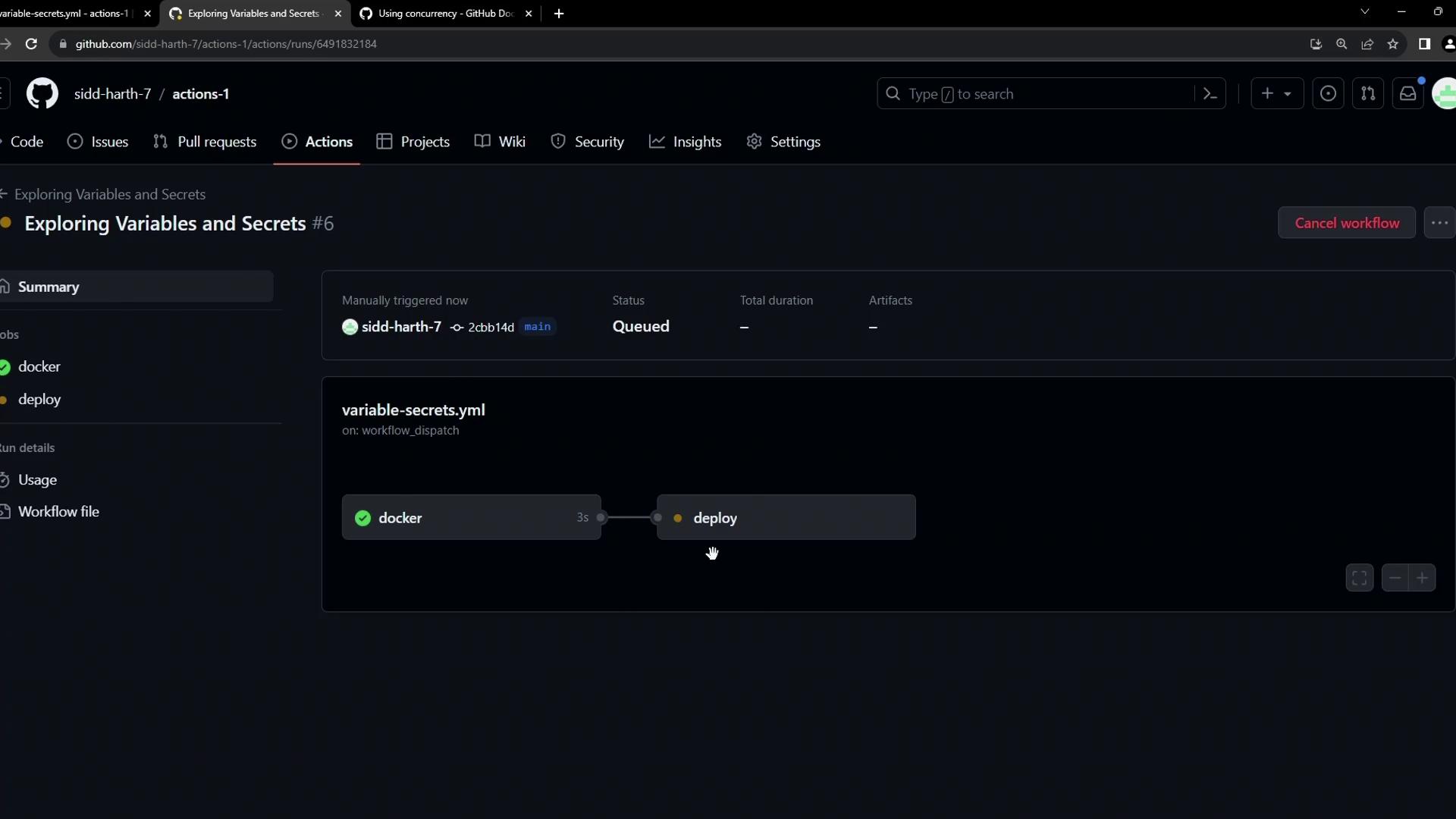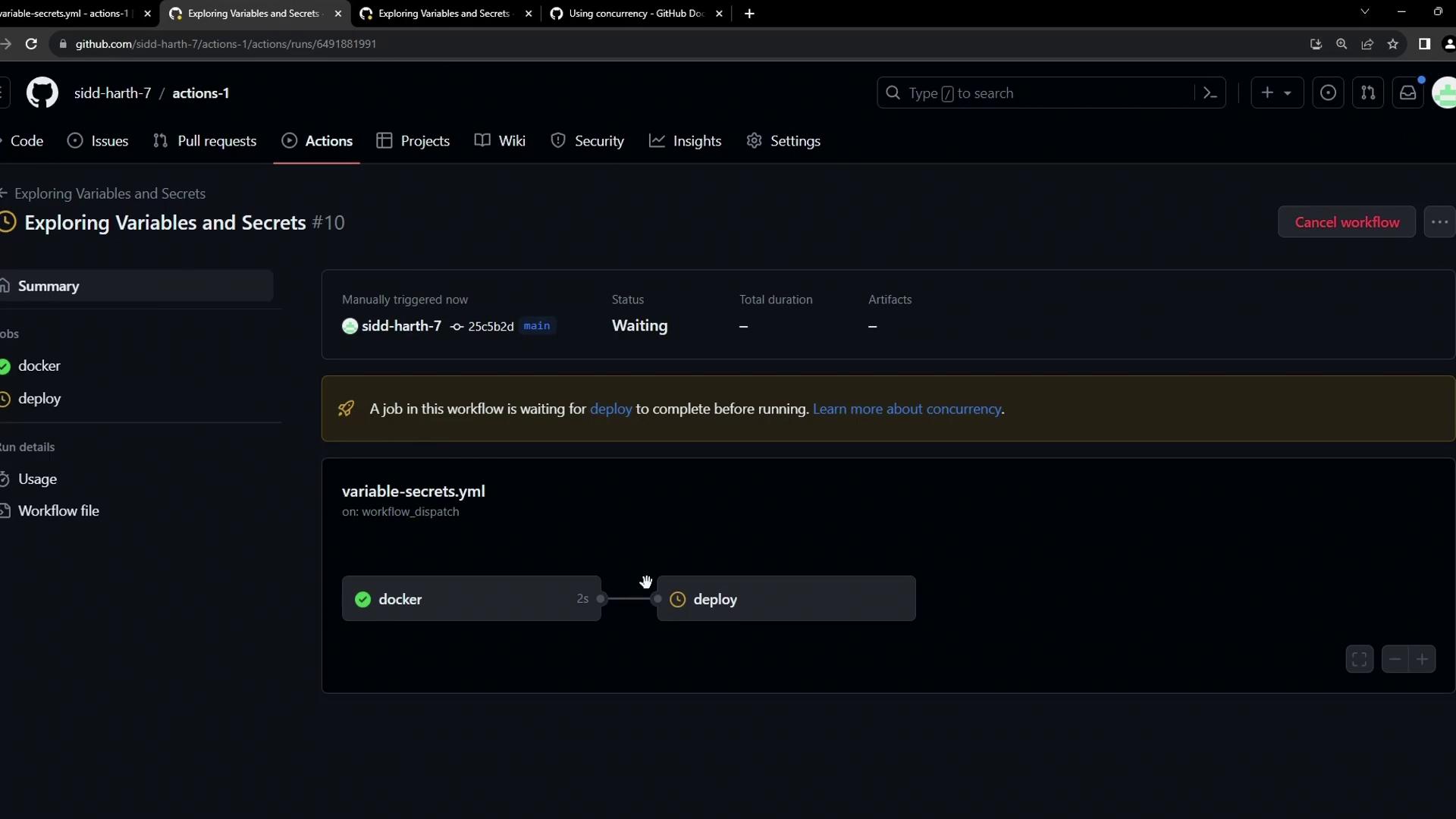GitHub Actions Certification
GitHub Actions Core Concepts
Using Job concurrency
In this guide, you’ll learn how to prevent overlapping deployments by using the concurrency key in GitHub Actions. We’ll start with a simple Docker build-and-publish workflow, simulate a long-running deployment, and then introduce concurrency controls to ensure only one deployment runs at a time.
1. Base Workflow
This workflow builds, logs in, and publishes a Docker image when manually triggered:
on:
workflow_dispatch:
env:
CONTAINER_REGISTRY: docker.io
IMAGE_NAME: github-actions-nginx
jobs:
docker:
runs-on: ubuntu-latest
steps:
- name: Docker Build
run: echo docker build -t ${{ env.CONTAINER_REGISTRY }}/${{ vars.DOCKER_USERNAME }}/${{ IMAGE_NAME }}:latest
- name: Docker Login
run: echo docker login --username=${{ vars.DOCKER_USERNAME }} --password=${{ secrets.DOCKER_PASSWORD }}
- name: Docker Publish
run: echo docker push ${{ env.CONTAINER_REGISTRY }}/${{ vars.DOCKER_USERNAME }}/${{ IMAGE_NAME }}:latest
2. Adding a Long-Running Deploy Job
To demonstrate overlapping runs, let’s add a deploy job that runs the container and then sleeps for 10 minutes:
jobs:
docker:
runs-on: ubuntu-latest
steps:
- name: Docker Build
run: echo docker build -t ${{ env.CONTAINER_REGISTRY }}/${{ vars.DOCKER_USERNAME }}/${{ IMAGE_NAME }}:latest
- name: Docker Login
run: echo docker login --username=${{ vars.DOCKER_USERNAME }} --password=${{ secrets.DOCKER_PASSWORD }}
- name: Docker Publish
run: echo docker push ${{ env.CONTAINER_REGISTRY }}/${{ vars.DOCKER_USERNAME }}/${{ IMAGE_NAME }}:latest
deploy:
needs: docker
runs-on: ubuntu-latest
steps:
- name: Docker Run
run: |
echo docker run -d -p 8080:80 ${{ env.CONTAINER_REGISTRY }}/${{ vars.DOCKER_USERNAME }}/${{ IMAGE_NAME }}:latest
sleep 600s
Warning
If you trigger this workflow while the previous deploy is still sleeping, you’ll end up with two simultaneous deployments—often a recipe for configuration drift or resource conflicts.
Once pushed, manually trigger the workflow:

3. Understanding Concurrency in GitHub Actions
GitHub Actions offers a concurrency key to group runs and control whether new runs cancel or queue behind in-progress ones:
| Key | Description | Default |
|---|---|---|
| group | Unique name for the concurrency group | none |
| cancel-in-progress | Cancel any in-flight runs in the same group (true/false) | false |
Note
Use a descriptive group name (for example, production-deployment) so unrelated workflows do not interfere with each other.

4. Enabling Concurrency on the Deploy Job
Add concurrency to the deploy job so that any new deployment run cancels the one in progress:
env:
CONTAINER_REGISTRY: docker.io
IMAGE_NAME: github-actions-nginx
jobs:
docker:
runs-on: ubuntu-latest
steps:
- name: Docker Build
run: echo docker build -t ${{ env.CONTAINER_REGISTRY }}/${{ vars.DOCKER_USERNAME }}/${{ IMAGE_NAME }}:latest
- name: Docker Login
run: echo docker login --username=${{ vars.DOCKER_USERNAME }} --password=${{ secrets.DOCKER_PASSWORD }}
- name: Docker Publish
run: echo docker push ${{ env.CONTAINER_REGISTRY }}/${{ vars.DOCKER_USERNAME }}/${{ IMAGE_NAME }}:latest
deploy:
needs: docker
concurrency:
group: production-deployment
cancel-in-progress: true
runs-on: ubuntu-latest
steps:
- name: Docker Run
run: |
echo docker run -d -p 8080:80 ${{ env.CONTAINER_REGISTRY }}/${{ vars.DOCKER_USERNAME }}/${{ IMAGE_NAME }}:latest
sleep 600s
After committing the change, triggering another run will immediately cancel the previous deploy:
docker run -d -p 8080:80 $CONTAINER_REGISTRY/siddharth67/$IMAGE_NAME:latest
Error: The operation was canceled.
5. Demonstration: Cancel in Progress = true
- Trigger Workflow A →
deploystarts and sleeps. - Trigger Workflow B → cancels A’s
deployjob and starts B’s.

You’ll see:
“The deploy job was canceled because a higher priority waiting request for the production deployment exists.”
6. Demonstration: Cancel in Progress = false
If you prefer to queue new runs behind in-progress ones, set cancel-in-progress: false:
deploy:
needs: docker
concurrency:
group: production-deployment
cancel-in-progress: false
runs-on: ubuntu-latest
steps:
- name: Docker Run
run: |
echo docker run -d -p 8080:80 ${{ env.CONTAINER_REGISTRY }}/${{ vars.DOCKER_USERNAME }}/${{ IMAGE_NAME }}:latest
sleep 600s
- Trigger Workflow A → sleeps in
deploy. - Trigger Workflow B → its
dockerjob runs immediately, but itsdeployjob waits.

Hovering over the pending job reveals it’s waiting for the prior deployment to finish.
Conclusion
By defining concurrency.group and choosing whether to cancel-in-progress, you can enforce single-instance deployments or queue them, protecting your production environment from conflicts and ensuring predictable rollouts.
Watch Video
Watch video content